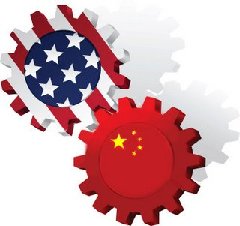| Many US politicians have raised their tones in criticizing China's huge trade surplus to the United States, claiming cheap products imported from China have squeezed many US citizens out of jobs. But that did not prevent many US technology firms from increasing their production capacities in China.
|

|
|
The economic relations of China and the United States.? |
During the past few years, US companies including Dell and Hewlett-Packard have accelerated their pace in expanding production capacity in China, especially in the western part of the country, which is a priority in China's development.
Those moves, though benefiting both US consumers and Chinese workers, have unfairly pushed China to the center of US criticism, with claims that many of the products US firms produce contribute to China's exports to the US, according to industry experts.
In 2009, the world's biggest PC maker, HP, launched a new laptop manufacturing base in Chongqing in Southwest China, with an annual production capacity of 24 million units. Its competitor, Dell, in August last year also kicked off its second operation center in neighboring Chengdu, Sichuan province.
The investment helped China's exports of computer products in November grow 42 percent year-on-year to $197 billion, compared to only 13-percent growth in China's PC market in the third quarter of last year.
"What we call 'Made in China' is indeed assembled in China, but what makes up the commercial value of the product comes from numerous countries," said Pascal Lamy, director-general of the World Trade Organization in a speech in October 2010.
Xing Yuqing and Neal Detert, researchers at the Asian Development Bank Institute, a think tank in Tokyo, said in a research note published last month that the traditional ways of measuring global trade have presented "a distorted picture" which fails to reflect the complexities of global commerce.
The research uses iPhone as an example, which in trade statistics is considered a Chinese export to the US, although the popular smartphone is actually designed and owned by a US company and is made largely of parts produced in several Asian and European countries.
"Most of the bilateral deficit associated with iPhone trade did not originate in China, as Chinese workers contributed a very small portion of the added value to an iPhone sold in the market," Xing and Detert said in the research.
They calculated that the estimated $178 wholesale cost of the shipped phone was credited to China under the current trade measurement, even though the value of the work performed by Chinese workers accounted for just 3.6 percent, or $6.50, of the total.
Although it is hard to estimate the real trade figures between the US and China, Lamy said if trade statistics were adjusted to reflect the actual value different countries contributed to a product, the size of the US trade deficit with China - more than $226 billion according to US figures - would be only about half of official figures.
Xing and Detert said globalization has created a situation where the high-tech products invented by US companies do not increase US exports, "but to the contrary exacerbate the US trade deficit."
"If US high-tech companies were to share their profits with low-skilled US workers by keeping assembly jobs in the US, it would be a more effective way to reduce the US trade deficit as currently calculated than by only targeting the exchange rate policy of China," they added. |

